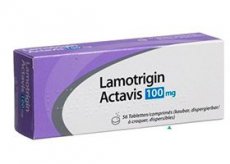Medical expert of the article
New publications
Preparations
Lamotrigine
Last reviewed: 03.07.2025

All iLive content is medically reviewed or fact checked to ensure as much factual accuracy as possible.
We have strict sourcing guidelines and only link to reputable media sites, academic research institutions and, whenever possible, medically peer reviewed studies. Note that the numbers in parentheses ([1], [2], etc.) are clickable links to these studies.
If you feel that any of our content is inaccurate, out-of-date, or otherwise questionable, please select it and press Ctrl + Enter.

Indications Lamotrigine
Indications for use of the drug include:
- generalized or partial forms of seizures (including tonic-clonic seizures, as well as seizures developing as a result of Lennox-Gastaut syndrome) - for children 12+ years old, as well as for adults for monotherapy of epileptic seizures or as an additional drug;
- as a monotherapy for typical forms of absences;
- as a prophylaxis of mood disorders (such as mania, depression or hypomania, as well as mixed cases) in patients aged 18+ suffering from manic-depressive psychosis.
 [ 6 ]
[ 6 ]
Pharmacodynamics
The drug helps stabilize neuronal membranes by acting on presynaptic sodium channels (potential-dependent). In addition, it suppresses the process of pathological release of 2-aminopentanedioic acid (this amino acid contributes to the development of epileptic seizures) and slows down depolarization caused by glutamate.
Pharmacokinetics
The active substance is completely and quickly absorbed from the gastrointestinal tract. After oral administration, peak concentration is reached after 2.5 hours. The absorption of the drug is slower if it is taken with food, but this does not affect its effectiveness. It circulates through the vessels in a protein-bound form (maximum 55% of the absorbed substance). The plasma clearance coefficient is approximately 0.2–1.2 ml/min per kilogram of weight, and the distribution volume is 0.9–1.3 l/kg.
Metabolism occurs in the liver through the process of glucuronidation. The half-life in adults is approximately 24-35 hours, in children it is usually shorter. The rate of this period is significantly affected by other drugs taken together with lamotrigine.
Excretion occurs mainly through the kidneys (in the form of glucuronides, with less than 10% excreted unchanged), and approximately 2% through the intestines.
Dosing and administration
Intended for oral administration. The frequency and duration of administration, as well as the dosage, are determined by the doctor individually for each patient. Children 12+ years old and adults are usually prescribed 25-200 mg twice a day (the maximum permissible daily dose is 700 mg); aged 2-12 years - 2-15 mg / kg twice a day (the maximum permissible daily dose is 400 mg).
Use Lamotrigine during pregnancy
During pregnancy, the drug is prohibited, except in situations where the potential benefit outweighs the risk of developing negative consequences for the fetus. According to the FDA rating, the drug is classified as category C.
Side effects Lamotrigine
Possible side effects include:
- organs of the nervous system: dizziness with headaches, insomnia or, on the contrary, drowsiness, severe fatigue, and in addition, aggressiveness, anxiety and irritability. Diplopia, tremor, confusion, balance problems, loss of visual acuity and conjunctivitis may also occur;
- organs of the hematopoietic system: leukopenia or thrombocytopenia;
- gastrointestinal tract: vomiting with nausea;
- Allergy: skin rash (mostly maculopapular; develops in the first 8 weeks of treatment), disappearing after discontinuation of the drug, hypersensitivity (swelling of the face, fever, hematological disorders (anemia) and liver disorders, as well as lymphadenopathy and, in rare cases, DIC or MOF). Rarely, Lyell's syndrome or Stevens-Johnson syndrome may develop.
Overdose
Symptoms of overdose include: drowsiness, headaches and dizziness, in addition to nystagmus with ataxia, vomiting, and coma.
To eliminate the symptoms, the patient must be hospitalized. Gastric lavage procedures are performed, activated carbon is prescribed, and symptomatic and supportive treatment is also provided.
Interactions with other drugs
Valproates are competitive blockers of liver enzymes, as a result of which the process of glucuronidation of lamotrigine is suppressed, and the rate of metabolism decreases and the average half-life increases (up to 70 hours).
Anticonvulsants that induce metabolizing liver enzymes (such as phenytoin with carbamazepine, as well as phenobarbital with primidone), as well as paracetamol, increase the rate of lamotrigine glucuronidation and its metabolism. In case of combined administration, the average half-life of the active component decreases approximately 2-fold (to 14 hours). There is information about the occurrence of side effects in the central nervous system - ataxia, dizziness, nausea, loss of visual acuity, diplopia (when using carbamazepine during treatment with lamotrigine). Symptoms disappear after reducing the dosage of carbamazepine.
When combined with combined oral contraceptives containing ethinyl estradiol (30 mcg) and levonorgestrel (150 mcg), the lamotrigine clearance coefficient increases (by about 2 times). As a result, the AUC and peak concentration values decrease (by an average of 52 and 39%, respectively). During the week during which the drug is not taken, the concentration of the active substance in the plasma increases (before taking a new dose, it is approximately 2 times higher than the values observed during active treatment).
Rifampicin increases the clearance rate of lamotrigine and also reduces its half-life by stimulating liver enzymes responsible for glucuronidation. Patients taking rifampicin as an additional treatment should be prescribed lamotrigine according to the regimen recommended for its combined use with glucuronidation-stimulating drugs.
Attention!
To simplify the perception of information, this instruction for use of the drug "Lamotrigine" translated and presented in a special form on the basis of the official instructions for medical use of the drug. Before use read the annotation that came directly to medicines.
Description provided for informational purposes and is not a guide to self-healing. The need for this drug, the purpose of the treatment regimen, methods and dose of the drug is determined solely by the attending physician. Self-medication is dangerous for your health.

